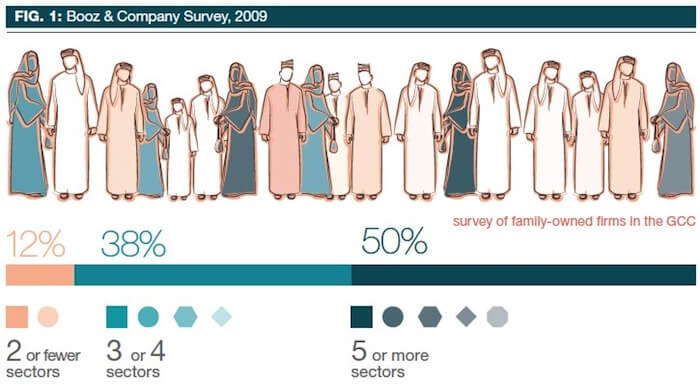Widely diversified family businesses are common in the GCC, often including units in more than ten unrelated industries under one holding structure. Although this may have been a viable growth strategy at one time, GCC family businesses now potentially face the task of divestment and consolidation. Ahmed Youssef, Partner at Booz & Company, elaborates on the relevant points of self-assessment for families in business and makes recommendations on how to handle diversity and regain focus.
Historically, wealthy families in the GCC have developed diversified portfolios of businesses for a variety of reasons: Access to capital and management talent made diversification possible, and the closed nature of local markets—which limited competition and capped the growth potential of existing businesses—made it necessary to enter new fields, often unrelated to the original family business, in order to keep growing and accumulating wealth. Diversity for the sake of diversification was a sound business strategy. Indeed, a 2009 Booz & Company survey of 25 family-owned firms in the GCC showed just how widespread this strategy is: Nearly half of the families were involved in five or more sectors, with nearly as many (40%) engaged in three or four sectors, and only 12% active in two sectors or fewer (See Figure 1 below). But the GCC business environment that favoured this diversification strategy is changing rapidly, forcing families to rethink how they manage their businesses to bring more focus to extensive operations. Competition is more intense from domestic and international rivals that now have access to capital, talent, and local markets. Meanwhile, retail and business customers are ever more sophisticated and demanding, which means family businesses need greater expertise and responsiveness to serve and retain their customers. Finally, financiers expect greater transparency and analysis of a family’s holdings before extending growth capital or credit–a tough adjustment for those families that used to keeping their books closed to outsiders.
Put simply: the old way of running a diversified portfolio of businesses in the GCC is not sustainable. Families need to evolve their business strategies. To choose the right path forward, they need to address three major issues:
Understanding the financials. Over the years, families have cobbled together so many companies that it can be difficult to ascertain exactly which businesses are thriving, which are treading water and which are failing. But unwrapping the financials of each business unit is vital. When capital and management time are abundant, an organisation can enter into any business as long as the return exceeds its cost of capital—or if management even believes that it will do so. However, when capital costs increase and management capacity is stretched thin, family conglomerates must focus on the best possible use of both capital and time. This will often mean divesting some of their traditional businesses or giving them less investment—which can be a difficult process if, for instance, the founder is sentimentally attached to an underperforming “original” business. Nevertheless, a frank financial and strategic assessment of each unit is critical to putting the family business on sound footing.
Understanding the capabilities
Once families have a clear picture of the business’s financials, they can see where their strengths are. To succeed, families need to identify what they do exceptionally well and focus on leveraging those distinctive capabilities. In brief, capabilities are the interconnected people, knowledge, systems, tools and processes that form systems to create differentiated value to customers. For instance, a family may realise it is very good at providing retail services, or running businesses that require low working capital. Once these capabilities are identified, a family has a blueprint for how to grow the business; in other words, which businesses to focus its resources and which businesses to exit. Over time, this process creates what’s known as “coherence”–an alignment of capabilities, products and services, and methods to capturing value in each market.
Understanding the family
Finally, a family must do some soul searching about its aspirations and philosophy. How is the family evolving as the third and fourth generations grow up? How do these younger family members want to be involved? Does the family business create cohesion or is it a source of friction and arguments? Some families worry that their collective identity is so tied to the business that any changes could jeopardise the family’s unity. But this is not necessarily the case. Even if a family’s business holdings are split into more autonomous parts among family members, each branch could retain shares and board seats in one another’s businesses to maintain ties as well as a sense of shared purpose and benefit.
Now What?
After tackling these three broad issues, a family should have obtained the requisite data, as well as essential insights into their strengths and aspirations, to intelligently choose a strategic path forward. There are three primary options.
Divest and focus
If there are businesses that clearly enjoy a “right to win” –i.e., the ability to engage in any competitive market with a better-than-even chance of success–based on the capabilities that the family has identified, the prudent choice is to focus on those businesses, build those capabilities, and divest the rest. But divestitures are often difficult in a family business. Some family members may have sentimental attachments to certain businesses. Others might have practical attachments if those businesses employ them. Here the rigorous analysis supporting a capabilities-driven strategy is especially helpful. It gives the divestitures context as a strategy to benefit the family as a whole, not an attack on a particular branch.
Create autonomy
Another option is to break the family business into smaller, more autonomous units run by different branches of the family. This strategy aligns family member expertise with business units and frees them to pursue higher returns without being held back by other units with different priorities. However, this approach raises tough questions, such as: how to divide and value the business units, how to promote ownership among the different branches of the family, and how to create accountability. If the family chooses to create these autonomous units, it could maintain cohesion by divvying up minority shareholdings among family members no longer directly involved in the business, or to require that family members sit on one another’s boards of directors. These are all legitimate strategies as long as each branch of the family is unambiguously accountable for its unit’s performance.
Keep the conglomerate
In the end, a family might decide that given its capabilities and aspirations it should retain the conglomerate structure. If, for instance, its distinguishing capability is an ability to manage businesses that need low working capital, then maintaining a collection of seemingly unrelated companies might make sense. It is important to note, however, that even the conglomerate model is actually driven by a capability-driven strategy–one that’s just not obvious to the casual observer. In an age of increasingly narrow specialisation, these families will need to introduce best practices to understand their portfolios better (with more transparent financials), manage them more effectively (guided by capabilities and coherence), and formalise family governance to ensure effective delegation and separation of activities (both business and non-business related) and to prepare for succession.In the end, there is no wrong answer for how families should design their strategy, but success depends on rigorous self-examination and a willingness to evolve. A family may even choose to continue its conglomerate structure–as long as a clear set of capabilities underpins this strategy. But the important point to understand is that diversity for the sake of diversification is no longer a sound business strategy in the GCC. Focus and expertise is how family businesses will win in the new business environment.
Tharawat Magazine, Issue 9, 2011

















